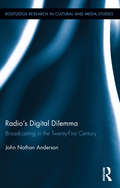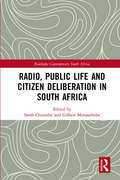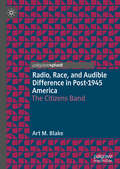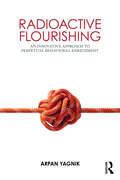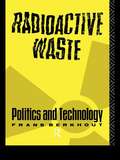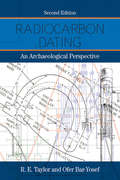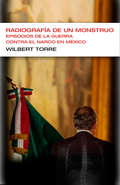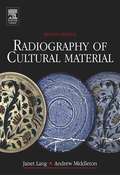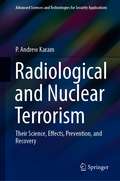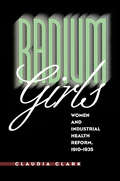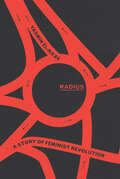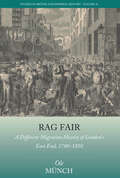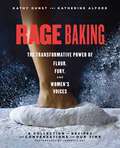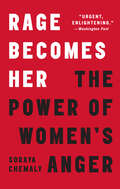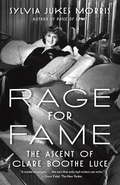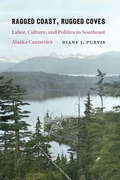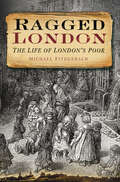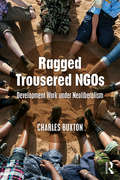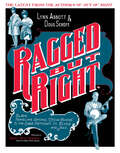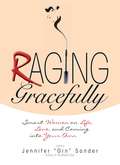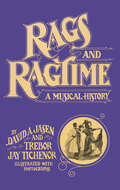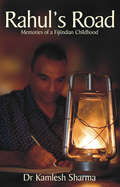- Table View
- List View
Radio's Digital Dilemma: Broadcasting in the Twenty-First Century (Routledge Research in Cultural and Media Studies #60)
by John Nathan AndersonRadio's Digital Dilemma is the first comprehensive analysis of the United States’ digital radio transition, chronicling the technological and policy development of the HD Radio broadcast standard. A story laced with anxiety, ignorance, and hubris, the evolution of HD Radio pitted the nation’s largest commercial and public broadcasters against the rest of the radio industry and the listening public in a pitched battle over defining the digital future of the medium. The Federal Communications Commission has elected to put its faith in "marketplace forces" to govern radio’s digital transition, but this has not been a winning strategy: a dozen years from its rollout, the state of HD Radio is one of dangerous malaise, especially as newer digital audio distribution technologies fundamentally redefine the public identity of "radio" itself. Ultimately, Radio’s Digital Dilemma is a cautionary tale about the overarching influence of economics on contemporary media policymaking, to the detriment of notions such as public ownership and access to the airwaves—and a call for media scholars and reformers to engage in the continuing struggle of radio’s digital transition in hopes of reclaiming these important principles.
Radio's Second Century: Past, Present, and Future Perspectives
by Bruce Mims John Allen Hendricks Daniel Riffe Brad Clark Mark Ward Lu Wu Laith Zuraikat Joseph R. Blaney David Crider Rachel Sussman-Wander Kaplan John F. Barber Emily W. Easton John Mark Dempsey Anjuli Joshi Brekke Anne F. MacLennan Archie McLean Michael Nevradakis Simon OrderOne of the first books to examine the status of broadcasting on its one hundredth anniversary, Radio’s Second Century investigates both vanguard and perennial topics relevant to radio’s past, present, and future. As the radio industry enters its second century of existence, it continues to be a dominant mass medium with almost total listenership saturation despite rapid technological advancements that provide alternatives for consumers. Lasting influences such as on-air personalities, audience behavior, fan relationships, and localism are analyzed as well as contemporary issues including social and digital media. Other essays examine the regulatory concerns that continue to exist for public radio, commercial radio, and community radio, and discuss the hindrances and challenges posed by government regulation with an emphasis on both American and international perspectives. Radio’s impact on cultural hegemony through creative programming content in the areas of religion, ethnic inclusivity, and gender parity is also explored. Taken together, this volume compromises a meaningful insight into the broadcast industry’s continuing power to inform and entertain listeners around the world via its oldest mass medium--radio.
Radio, Public Life and Citizen Deliberation in South Africa (Routledge Contemporary South Africa)
by Sarah ChiumbuThis book critically analyses the important role of radio in public life in post-apartheid South Africa. As the most widespread and popular form of communication in the country, radio occupies an essential space in the deliberation and the construction of public opinion in South Africa. From just a few state-controlled stations during the apartheid era, there are now more than 100 radio stations, reaching vast swathes of the population and providing an important space for citizens to air their views and take part in significant socio-economic and political issues of the country. The various contributors to this book demonstrate that whilst print and television media often serve elite interests and audiences, the low cost and flexibility of radio has helped it to create a ‘common’ space for national dialogue and deliberation. The book also investigates the ways in which digital technologies have enhanced the consumption of radio and produced a sense of imagined community for citizens, including those in marginalised communities and rural areas. This book will be of interest to researchers with an interest in media, politics and culture in South Africa specifically, as well as those with an interest in broadcast media more generally.
Radio, Race, and Audible Difference in Post-1945 America: The Citizens Band
by Art M. BlakeIn the second half of the twentieth century, new sounds began to reverberate across the United States. The voices of African-Americans as well as of women, Latinx, queer, and trans people broke through in social movements, street protests, and in media stories of political and social disruption. Postwar America literally sounded different. This book argues that new technologies and new mobilities sharpened American attention to these audibly coded identities, on the radio, on the streets and highways, in new music, and on television. Covering the Puerto Rican migration to New York in the 1950s, the varying uses of CB radio by white and African American citizens in the 1970s, and the emergence of audible queerness, Art M. Blake attunes us to the sounds of race, mobility, and audible difference. As he argues, marginalized groups disrupted the postwar machine age by using new media technologies to make themselves heard.
Radioactive Flourishing: An Innovative Approach to Perpetual Behavioral Enrichment
by Arpan YagnikRadioactive Flourishing is for seekers of lasting happiness and peace. Radioactive Flourishing supplies cognitive insights for eventual behavioral stability. The USP of the book is its flipped human response toward instability. This book’s primary goal is to help people learn ways to flourish individually despite being surrounded by instability.This book is intentionally written in the "katha" style, which means that there are numerous relatable stories and a consistent journey from the core to the periphery, then to the tangent, and back. The implicit and explicit repetition of the key manifest enables the core intervening stimulation to encourage its readers to dig deeper and find solid footing in their flourishing being. This book is for seekers of happiness and peace.This book will be useful to students, researchers, young professionals, and faculty members working in the fields of business administration, psychology, start-ups, finance, entrepreneurship, and communication. It will also be an invaluable resource for aspiring leaders and students of life.
Radioactive Waste: Politics and Technology (The Natural Environment: Problems and Management)
by Frans BerkhoutRadioactive Waste provides a detailed historical account of the policy and practice of radwaste management in Britain, Sweden and the Federal Republic of Germany. In their differing approaches, these three countries define the parameters of civil nuclear strategy in Europe. The comparative analysis of the evolution of policy clarifies the context of political and technical decision-making. Assessing the varying degrees of influence which the public, the industry and the government exercise over these actions, Frans Berkhout applies the concept of boundaries of control', questioning the extent to which such control can be relinquished. This analysis of nuclear strategy, the politics of nuclear power and the shifting emphasis of government regulation redefines the issue of radwaste management and sets it at the centre of the current debate about power, the environment and society.
Radiocarbon Dating: An Archaeological Perspective
by Ofer Bar-Yosef R.E. TaylorThis volume is a major revision and expansion of Taylor’s seminal book Radiocarbon Dating: An Archaeological Perspective. It covers the major advances and accomplishments of the 14C method in archaeology and analyzes factors that affect the accuracy and precision of 14C-based age estimates. In addition to reviewing the basic principles of the method, it examines 14C dating anomalies and means to resolve them, and considers the critical application of 14C data as a dating isotope with special emphasis on issues in Old and New World archaeology and late Quaternary paleoanthropology. This volume, again a benchmark for 14C dating, critically reflects on the method and data that underpins, in so many cases, the validity of the chronologies used to understand the prehistoric archaeological record.
Radiografía de un monstruo
by Wilbert TorreLa historia más allá de los cables; el libro definitivo sobre la relación México-Estados Unidos y la guerra contra el narcotráfico. Un análisis exhaustivo de las filtraciones de Wikileaks sobre México, pero sobre todo de archivos confidenciales de la CIA que hablan sobre el papel injerencista de Estados Unidos en México. Al margen de lo publicado por la prensa mexicana y estadounidense y de algunos libros que lo han abordado de manera superficial y pasajera, casi no existe literatura sobre el sistema de cooperación bilateral en la guerra contra el narco. Radiografía de un monstruo surge después de una exhaustiva clasificación de los cables mexicanos de Wikileaks, el análisis de archivos nacionales y documentos clasificados del departamento de Estado norteamericano, con el objetivo de abordar con rigor y detalle la relación entre México y Estados Unidos en la lucha contra el narcotráfico. Radiografía de un monstruo aborda la actitud de enfado tomada por el gobierno mexicano y el entonces presidente Felipe Calderón ante el contexto que desencadenó la información revelada por Julian Assange, y que fue enmarcada por el conflicto que el presidente encaró con el embajador Pascual, en dónde se pide su renuncia; la reunión privada del presidente de México con Hilary Clinton, descrita por ella como "su peor encuentro con un jefe de estado"; y la posterior visita del presidente Calderón a Estados Unidos. Estos hechos cambiaron totalmente la relación de estos dos países en la guerra contra el narcotráfico. Este libro es un fragmento del libro Narcoleaks, de Wilbert Torre y ponen especial énfasis en la transformación que sufrió la relación diplomática de México y Estados Unidos con respecto a la guerra contra el narcotráfico a partir del descubrimiento de los cables secretos conocidos como wikileaks.
Radiography of Cultural Material
by Julia Tum Andrew MiddletonRadiography can be an invaluable tool for the study of a diverse array of cultural materials including metals, ceramics, paper, paintings and human and animal remains. In this book, experts in the field bring to life their experiences with the different materials, describing the techniques that can be employed to discover the stories behind the objects. This second edition, available in paperback for the first time, includes new case studies and images, as well as whole new sections on digital imaging, quality control and animal mummies.
Radiological and Nuclear Terrorism: Their Science, Effects, Prevention, and Recovery (Advanced Sciences and Technologies for Security Applications)
by P. Andrew KaramThis book discusses multiple aspects of radiological and nuclear terrorism. Do you know what to do if there is a radiological or nuclear emergency in your city? These accidents are not common, but they have happened – and even though we have not seen an attack using these weapons, governments around the world are making plans for how to prevent them – and for how to respond if necessary. Whether you are an emergency responder, a medical caregiver, a public health official – even a member of the public wanting to know how to keep yourself and your loved ones safe – there is a need to understand how these weapons work, how radiation affects our health, how to stop an attack from taking place, how to respond appropriately in the event of an emergency, and much more.Unfortunately, the knowledge that is needed to accomplish all of this is lacking at all levels of society and government. In this book, Dr. Andrew Karam, an internationally respected expert in radiation safety and multiple aspects of radiological and nuclear emergencies, discusses how these weapons work and what they can do, how they can affect our health, how to keep yourself safe, and how to react appropriately whether you are a police officer investigating a suspect radiological weapon, a firefighter responding to a radiological or nuclear attack, a nurse or physician caring for potentially contaminated patients, or a governmental official trying to keep the public safe. To do this, he draws upon his extensive experience in the military, the several years he worked directly with emergency responders, his service on a number of advisory committees, and multiple trips overseas in the aftermath of the Fukushima accident and on behalf of the International Atomic Energy Agency, Interpol, and the Health Physics Society.
Radium Girls: Women and Industrial Health Reform, 1910–1935
by Claudia ClarkIn the early twentieth century, a group of women workers hired to apply luminous paint to watch faces and instrument dials found themselves among the first victims of radium poisoning. Claudia Clark's book tells the compelling story of these women, who at first had no idea that the tedious task of dialpainting was any different from the other factory jobs available to them. But after repeated exposure to the radium-laced paint, they began to develop mysterious, often fatal illnesses that they traced to conditions in the workplace. Their fight to have their symptoms recognized as an industrial disease represents an important chapter in the history of modern health and labor policy. <p><p> Clark's account emphasizes the social and political factors that influenced the responses of the workers, managers, government officials, medical specialists, and legal authorities involved in the case. She enriches the story by exploring contemporary disputes over workplace control, government intervention, and industry-backed medical research. Finally, in appraising the dialpainters' campaign to secure compensation and prevention of further incidents--efforts launched with the help of the reform-minded, middle-class women of the Consumers' League--Clark is able to evaluate the achievements and shortcomings of the industrial health movement as a whole.
Radius: A Story of Feminist Revolution
by Yasmin El-RifaeA haunting, intimate account of the women and men who built a feminist revolution in the middle of the Arab Spring.In 2012, the joyful hopes of the democratic Egyptian Revolution were tempered by revelations of mass sexual assault in Tahrir Square in Cairo, the revolution&’s symbolic birthplace.This is the story of the women and men who formed Opantish - Operation Anti-Sexual Harassment - who deployed hundreds of volunteers, scouts rescue teams, and getaway drivers to intervene in the spiraling cases of sexual violence against women protesters in the square. Organized and led by women during 2012–2013 - the final, chaotic months of Egypt&’s revolution - teams of volunteers fought their way into circles of men to pull the woman at the center to safety. Often, they risked assault themselves.Journalist Yasmin El-Rifae was one of Opantish&’s organizers, and this is her evocative, aching account of their work, as they raced to develop new tactics, struggled with a revolution bleeding into counter-revolution, and dealt with the long aftermath of assault and devastation. Told in a daring, hybrid narrative style drawn from years of interviews and her own, intimate experience, it is a story of overlapping circles: the circles of male attackers activists had to break through, the ways sexual violence can be circled off as &“irrelevant&” to political struggle, and the endless repetitive loops of living with trauma.Introducing a powerful new voice, a writer whose searchingly beautiful, spare prose cuts to the core of a story ever more urgent and relevant: of women&’s resistance when all else has failed.
Rag Fair: A Different Migration History of London’s East End, 1780-1850 (Studies in British and Imperial History #10)
by Ole MünchIn the early Victorian age, the streets of East London were home to migrants from different regions and religions. In the midst of this area lay the famous Rag Fair street market, sustained by trade routes stretching across the globe. The market’s history demonstrates that it was not only a place of economic exchange, but also an intercultural contact zone where Jewish and Irish migrants mingled, entered client relationships and forged political alliances. Reconstructing the varied (partly multiethnic) group-building processes operating in the market, Rag Fair draws on approaches across migration history, economic history, economic anthropology and the sociology of political movements to uncover the social mechanisms at work in the old clothing trade.
Rage Baking: The Transformative Power of Flour, Fury, and Women's Voices
by Kathy Gunst Katherine Alford50+ recipes, short essays, and quotes from some of the best bakers, activists, and outspoken women in our country today—this cookbook encourages women to use sugar and sass as a way to defend, resist, and protest. Since the 2016 election, many women across the country have felt rage, fury, and frustration, wondering how we got here. Some act by calling their senators, some write checks, some join activist groups, march, paint signs, grab their daughters and sons, and raise their voices. But for so many, they also turn to their greatest comfort—their kitchen. Baking has a new meaning in today&’s world. These days, baking can be an outlet for expressing our feelings about the current state of our society. Rage Baking offers more than 50 cookie, cake, tart, and pie recipes as well as inspirational essays, reflections, and interviews with well known bakers and impassioned women and activists including Dorie Greenspan, Ruth Reichl, Carla Hall, Preeti Mistry, Julia Turshen, Pati Jinich, Vallery Lomas, Von Diaz, Genevieve Ko, and writers like Rebecca Traister, Pam Houston, Tess Raffery, Cecile Richards, Ann Friedman, Marti Noxon, and many more. Timely, fun, and creative, this cookbook speaks to both skilled and beginner bakers who are looking for new ways to use their sweetest skills to combine food and activism. Containing a collection of recipes that are satisfying and delicious, Rage Baking unites like-minded women who are passionate about baking and change.
Rage Becomes Her: The Power of Women's Anger
by Soraya Chemaly***A BEST BOOK OF 2018 SELECTION*** NPR * The Washington Post * Book Riot * Autostraddle * Psychology Today ***A BEST FEMINIST BOOK SELECTION*** Refinery 29, Book Riot, Autostraddle, BITCH Rage Becomes Her is an &“utterly eye opening&” (Bustle) book that gives voice to the causes, expressions, and possibilities of female rage.As women, we&’ve been urged for so long to bottle up our anger, letting it corrode our bodies and minds in ways we don&’t even realize. Yet there are so, so many legitimate reasons for us to feel angry, ranging from blatant, horrifying acts of misogyny to the subtle drip, drip drip of daily sexism that reinforces the absurdly damaging gender norms of our society. In Rage Becomes Her, Soraya Chemaly argues that our anger is not only justified, it is also an active part of the solution. We are so often encouraged to resist our rage or punished for justifiably expressing it, yet how many remarkable achievements would never have gotten off the ground without the kernel of anger that fueled them? Approached with conscious intention, anger is a vital instrument, a radar for injustice and a catalyst for change. On the flip side, the societal and cultural belittlement of our anger is a cunning way of limiting and controlling our power—one we can no longer abide. &“A work of great spirit and verve&” (Time), Rage Becomes Her is a validating, energizing read that will change the way you interact with the world around you.
Rage for Fame
by Sylvia MorrisDetailed and rich with mesmerizing narrative, Rage for Fame recounts the story of the flowering years of Clare Booth Luce--a former congresswoman and editor of Vanity Fair--a striking woman whose private life was as intriguing and spectacular as her public life. 45 photos.From the Hardcover edition.
Ragged Coast, Rugged Coves: Labor, Culture, and Politics in Southeast Alaska Canneries
by Diane J. PurvisRagged Coast, Rugged Coves explores the untold story of cannery workers in Southeast Alaska from 1878, when the first cannery was erected on the Alexander Archipelago, through the Cold War. The cannery jobs brought waves of immigrants, starting with Chinese, followed by Japanese, and then Filipino nationals. Working alongside these men were Alaska Native women, trained from childhood in processing salmon. Because of their expertise, these women remained the mainstay of employment in these fish factories for decades while their husbands or brothers fished, often for the same company. Canned salmon was territorial Alaska&’s most important industry. The tax revenue, though meager, kept the local government running, and as corporate wealth grew, it did not take long for a mix of socioeconomic factors and politics to affect every aspect of the lands, waters, and population. During this time the workers formed a bond and shared their experiences, troubles, and joys. Alaska Natives and Chinese, Japanese, and Filipino immigrants brought elements from their ethnic heritage into the mix, creating a cannery culture. Although the labor was difficult and frequently unsafe, the cannery workers and fishermen were not victims. When they saw injustice, they acted on the threat. In the process, the Tlingits and Haidas, clans of Southeast Alaska for more than ten thousand years, aligned their interests with Filipino activists and the union movement. Ragged Coast, Rugged Coves tells the powerful story of diverse peoples uniting to triumph over adversity.
Ragged London: The Life of London's Poor
by Michael Fitzgerald Michael FitzGeraldRagged London describes life in the rookeries of London, where forty people would live together in one room. Although life was a constant struggle against famine, disease and violence, the people enjoyed a closeness that was moer than the result of overcrowding. Their lives were lived entirely within the 'mean streets' of their little corner of London. They were born and raised within the rookeries, earned their meagre living there, enjoyed life as best they could, dressed in the latest fashion, got married, had children, died and were buried there. The lack of cooking facilities led to them inventing the takeaway, and there was absolutely no sanitation. In the poorest district of all, St Giles, only a single water pump serviced the entire population. It was a closed world, although the population explosion of nineteenth-century London led to millions of new arrivals in the already-congested rookery districts. The areas were lawless to a degree that dwarfs contemporary concerns about crime. Though life as cheap in the rookeries, they produced some of the best soldiers and sailors in the British armed forces.
Ragged Trousered NGOs: Development Work under Neoliberalism
by Charles BuxtonRagged Trousered NGOs is a compelling first-hand account of the NGO sector and wider civil society over the past 40 years, examining how and why people take collective action and engage in social development projects. The book explores different organisational and methodological aspects of NGO work and social action, asking what was possible to achieve at a grass-roots level at different times, in different economic and political contexts in the East and West. Adopting a critical perspective, the author argues that social action continues to play a vital and varied role, and yet it struggles to challenge deep-rooted power relations and traditional forms of behaviour in today's unequal world. In particular, the book draws on examples from the former Soviet Union in transition, and the UK's voluntary sector over the last 40 years, with a view to challenging Eurocentric views about organisations and communities. The analysis adopts a Gramscian view of hegemony and an internationalist and anti-war position on key issues arising in recent armed conflicts and the new cold war with Russia. The book concludes by addressing the challenges for development workers, noting the precarious nature of NGO work despite its many achievements, and suggesting ways in which social activists can pick up more strength and support. This book's practical perspective on progressive forms of organisational management will be of considerable interest to civil society and NGO development workers, as well as to researchers and students in the fields of international development, politics, sociology and regional studies.
Ragged but Right: Black Traveling Shows, "Coon Songs," and the Dark Pathway to Blues and Jazz (American Made Music Series)
by Lynn Abbott Doug SeroffThe commercial explosion of ragtime in the early twentieth century created previously unimagined opportunities for black performers. However, every prospect was mitigated by systemic racism. The biggest hits of the ragtime era weren't Scott Joplin's stately piano rags. “Coon songs,” with their ugly name, defined ragtime for the masses, and played a transitional role in the commercial ascendancy of blues and jazz. In Ragged but Right, Lynn Abbott and Doug Seroff investigate black musical comedy productions, sideshow bands, and itinerant tented minstrel shows. Ragtime history is crowned by the “big shows,” the stunning musical comedy successes of Williams and Walker, Bob Cole, and Ernest Hogan. Under the big tent of Tolliver's Smart Set, Ma Rainey, Clara Smith, and others were converted from “coon shouters” to “blues singers.” Throughout the ragtime era and into the era of blues and jazz, circuses and Wild West shows exploited the popular demand for black music and culture, yet segregated and subordinated black performers to the sideshow tent. Not to be confused with their nineteenth-century white predecessors, black, tented minstrel shows such as the Rabbit's Foot and Silas Green from New Orleans provided blues and jazz-heavy vernacular entertainment that black southern audiences identified with and took pride in.
Raging Gracefully: Smart Women on Life, Love, And Coming into Your Own
by Jennifer Basye SanderIn Raging Gracefully, women just like you give voice to the unique challenges and choices that color this glorious yet gut-wrenching time of life. This engaging, endearing collection of true-life stories reveals the guts and glory of women old enough to know who they are--and run with it: a grieving widow of forty-nine experiences the healing powers of friendship, laughter, and water while vacationing and skinny-dipping in Mexico with sister-friends; a committed bachelorette has a change of heart and ties the knot in her sixtieth year; and a once mild-mannered woman raves about her unexpected menopausal rage, whiskers, weight gain, crushing fatigue, and crashing libido, and refuses to go without a fight into that dark crone's night. In mid-life the truth comes out whether we like it or not--about life, about death, about what really matters. We take on everything from children who won't grow up and parents who become children to about-face career changes and relationship rescues (or not). But through it all we can still have some fun, and this is the book that proves it! So treat yourself to a little graceful raging!
Rags and Ragtime: A Musical History (Dover Books On Music: History)
by Trebor Jay Tichenor David A. Jasen"A work for all time . . . (with) a tremendous amount of historical information which has never been published. . . . It will be the standard text and reference work in the ragtime field." -- Rag Times.This well-known, highly praised book is the definitive history of ragtime music and its composers. Both authors are widely celebrated composers, performers, collectors, historians, and critics of ragtime music. With great enthusiasm and expertise, they trace the growth and diversification of ragtime from its earliest beginnings in the late nineteenth century through its heyday in the Folk, Classic, Popular, Novelty, and Stride Ragtime periods to its current revival.Forty-eight major composers are discussed, including Scott Joplin, Zez Confrey, Jelly Roll Morton, Fats Waller, and many other greats. In addition, 800 important rags are profiled, most of them bearing the carefree titles that were part of the tradition, titles like "Canned Corn Rag," "Bantam Step," "Too Much Raspberry," "Ragging the Scale," and "Red Onion Rag." Each profile includes date of publication, original publisher, a discography, and a commentary of the unique character and appeal of each rag.Over 100 photographs, many of them rare, illuminate this lively chronicle, along with reproductions of original sheet music and many other items of interest from the authors' personal archives."Jasen and Tichenor have no peers in ragtime knowledge. . . .They are the two unchallengeable authorities in the field of ragtime history, personalities, and musical forms." -- The Classic Rag."A combination encyclopedia/biography/history/analysis and review, it teems with what would appear to be everything the ragtime buff or casual inquirer needs or wants to know about the music that won't stand still." -- The Christian Science Monitor."Rags and Ragtime tells it all. There's a lot here I didn't know in pictures, music, and words." -- Eubie Blake.
Rahel Varnhagen: The Life of a Jewish Woman
by Hannah Arendt Clara Winston Richard WinstonRahel Varnhagen (1777-1833) lived during the crucial period of assimilation in Germany, when it seemed imperative for Jews to escape their Jewishness.
Rahul’s Road: Memories of a Fijiindian Childhood
by Dr Kamlesh SharmaRahul's Road is a story of childhood in a Fijiindian village, Korovuto in Nadi on the largest island of the Fijian archipelago in the South Pacific. It presents a rich tapestry of the details of what it was like to grow up in a poor Fijiindian family. It captures moments of growing-up in Fiji with vividness and sensitivity. Written with feeling, the author's language has a simplicity that is quite remarkable in its richness and associations. The story told is complex, moving and vividly narrated. Rahul's Road will echo in the mind and memory of many Fijiindians within and outside their place of birth. It is a book for children, adolescents, adults who care about Fiji and the struggles and strengths of a migrant community. It cuts across barriers and builds bridges of memory, remembrance and understanding.
Raiders and Rebels: A History of the Golden Age of Piracy
by Frank SherryI he most authoritative history of piracy, Frank Sherry's rich and colorful account reveals the rise and fall of the real "raiders and rebels" who terrorized the seas. From 1692 to 1725 pirates sailed the oceans of the world, plundering ships laden with the riches of India, Africa, South America, and the Caribbean. Often portrayed as larger-than-life characters, these outlaw figures and their bloodthirsty exploits have long been immortalized in fiction and film. But beneath the legends is the true story of these brigands—often common men and women escaping the social and economic restrictions of 18th-century Europe and America. Their activities threatened the beginnings of world trade and jeopardized the security of empires. And together, the author argues, they fashioned a surprisingly democratic society powerful enough to defy the world.
